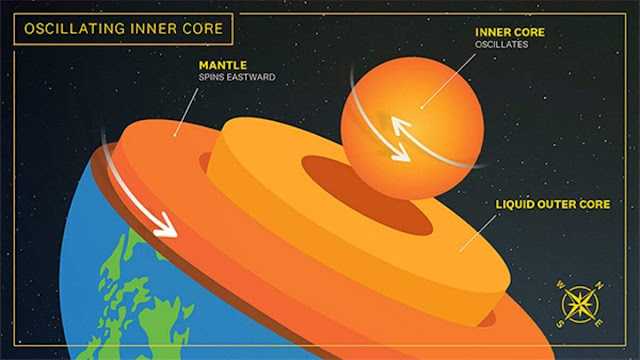Earth’s inner core is making scientists’ heads spin

Image: Geology In
Per a new peer-reviewed study published in Nature Geoscience, Earth’s inner core has stopped spinning in the same direction as the rest of the planet – and may even be rotating the other way. Cue sad planet breakup songs☹️.
🌎🔁 Background: Earth’s inner core is a superhot, Pluto-sized ball of solid iron located ~3,100 miles below the surface. It’s able to spin independently from Earth, since it floats within an outer core of piping-hot liquid metal.
And not to burst any bubbles, but Journey to the Center of the Earth wasn’t a documentary😱. The furthest humans have ever dug into our planet is ~7.6 miles (40,230 ft) – or about 3,092.4 miles away from the Earth’s inner core. What little data we have comes from analyzing tiny differences in earthquake-related seismic waves as they pass through the middle of the planet.
- In the newly-published study, Chinese researchers analyzed seismic waves from the last six decades and found Earth’s inner core rotation "came to near halt around 2009 and then turned in an opposite direction."
- The study’s authors concluded that our planet’s inner core oscillates between rotating one direction and then the other, with the switch occurring roughly every 35 years (or 70 years to complete one full rotation cycle).
✋ Yes, but… Other geological experts have pushed back against the study’s conclusion, arguing that it’s just one of several plausible explanations for the data. Other possibilities include a shorter 20- or 30-year rotation cycle, or a theory that Earth’s inner core only significantly moved between 2001 to 2013 and has stayed put ever since.
Share this!
Recent Science & Emerging Tech stories

Science & Emerging Tech
| January 19, 2023Why you probably won’t make it all the way through this newsletter
🖥👀 The average US knowledge worker spends 47 seconds on any one computer, phone, or tablet screen before switching to another screen, per new research from scientists at UC Berkeley and Microsoft.

Science & Emerging Tech
| January 17, 2023The tech that would’ve made Back to the Future five minutes long
⚡️ Potentially dangerous lightning strikes can be diverted to a safer path by beaming a high-powered laser into the sky, per a new peer-reviewed study published yesterday in Nature Photonics.

Science & Emerging Tech
| January 11, 2023The secret behind Roman concrete has finally been revealed
💪🏗 The strength of Roman concrete can be attributed to a special mixing process called “hot mixing,” which allows buildings made with the material to literally repair themselves, per a new peer-reviewed study.
You've made it this far...
Let's make our relationship official, no 💍 or elaborate proposal required. Learn and stay entertained, for free.👇
All of our news is 100% free and you can unsubscribe anytime; the quiz takes ~10 seconds to complete